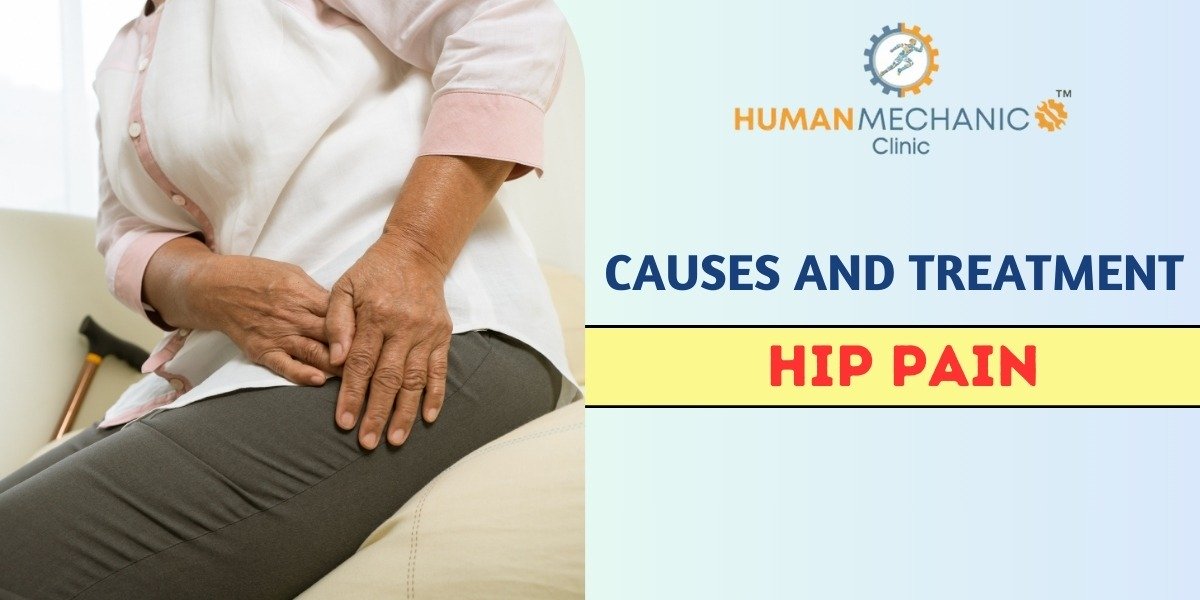Hip pain is a common complaint that can cause a wide variety of problems. The precise location of hip pain can provide clues about the underlying cause. Problems within the hip joint itself tend to result in pain on the inside of the hip or the groin. Hip pain on the outside of the hip, upper thigh, or outer buttock is usually caused by problems with muscles, ligaments, tendons, and other soft tissues that surround the hip joint. Conditions in other areas of the body, such as the lower back can sometimes cause hip pain. This type of pain is called referred pain. If you or your loved one struggling with hip pain and looking for hip pain treatment in Pune consider visiting Human Mechanic Clinic at Hadapsar Or Koregaon Park.
Causes of Hip Pain
Arthritis
- Osteoarthritis
- Rheumatoid arthritis
- Psoriatic arthritis
- Septic arthritis
- Juvenile idiopathic arthritis
Injuries
- Bursitis
- Dislocation
- Hip fracture
- Hip labral tear
- Inguinal hernia
- Sprains (Stretching or tearing of a tissue band called a ligament, which connects two bones in a joint.)
- Tendinitis
Pinched nerves
- Meralgia paresthetica
- Sacroiliitis
- Sciatica (Pain that travels along the path of a nerve that runs from the lower back down to each leg.)
Other problems
- Avascular necrosis (osteonecrosis). (The death of bone tissue due to limited blood flow.)
- Fibromyalgia
- Legg-Calve-Perthes disease (in children)
- Osteomyelitis
- Osteoporosis
- Synovitis
Cancer
- Advanced (metastatic) cancer that has spread to the bones
- Bone cancer
- Leukemia
When to contact a doctor
- If you have hip pain that lasts longer than a few days.
- if the hip is bleeding you can see exposed bone or muscle, a popping noise occurs, or you can’t bear weight.
- if your hip joint appears deformed or is swollen, or if you have severe pain.
Prompt medical attention is necessary for hip pain accompanied by any of the following:
- swelling
- tenderness
- soreness
- warmth
- redness
Diagnosis
Your healthcare provider will perform various tests, depending on your symptoms and pain will suggest scans /tests such as
- X-rays
- CT scans
- MRI scans
- Ultrasounds
- Blood tests
Treatment
A healthcare provider will suggest treatments based on the pain’s severity and its cause.
RICE method for hip pain. You can usually treat hip pain at home with the RICE method:
- Rest – Stop the physical activity that caused the pain to avoid making the injury worse.
- Ice – Apply an ice pack or cold compress for 10 to 15 minutes every hour for the first day after your injury. After one day, you can apply ice every three to four hours. Don’t apply ice directly to your
- Compression – Compression helps reduce blood flow to your injured hip and reduces swelling. Apply a compression bandage or wrap around your hip. You can also wear compression shorts or pants to help keep pressure on your hip.
- Elevation – If possible, lift your hips and lower body above the level of your heart. Support your leg with pillows, blankets, or cushions.
Physical therapy for hip pain
Your provider might suggest physical therapy if you have arthritis or a structural issue that’s causing pain. A physical therapist will show you stretches and exercises that strengthen the muscles around your affected hip. This should improve your stability and can relieve pain.
Various manual therapy techniques are used to increase the range of motion of the joint, and muscle energy techniques (MET) to reduce pain and stiffness.
Alternatively, therapies/ treatment options used are
- Cupping therapy
- Dry needling
- Taping
Various electrotherapy equipment are also used to control the pain/inflammation/ muscle problems such as
- Matrix therapy
- Extracorporeal shockwave therapy (SWT)
- Therapeutic laser
- TMS (tissue magnetic stimulation)
- IFT/ TENS
- TECAR therapy
Blog Written By Dr. Ashwini Kapoor – Consultant Physiotherapist At Human Mechanic Clinic, Pune.
